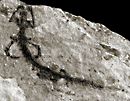Citations
 >
> Genomic
junk
>
> Genomic
junk
Not
only is the high percentage of "junk DNA" in the recently
decoded human genome harmless, but, according to Wen-Hsiung
Li, the George Wells Beadle professor of ecology and
evolutionary biology, it may actually provide clues to how human
genes evolved. In a computational analysis published in the February
12 Nature, Li's team found that 46 percent of the human
genome is "junk"-that is, stretches of noncoding DNA
with no apparent function other than to repeat base-pair sequences.
A surprisingly large number of the repetitive DNA was found in
translated proteins, which means the "junk" has been
spliced along with encoded genes during the molecular busywork
of protein creation. Li believes it's possible that, over time,
the indiscriminate splicing created new proteins that differentiated
humans from other species. The researchers are studying the location
and distribution of the repetitive elements to retrace their steps
over an evolutionary timeframe.
>
> Malaria
prevention in sight?
Triclosan,
a common antiseptic used in personal-care products such as toothpaste,
skin creams, and deodorants, kills the parasites responsible for
malaria and toxoplasmosis, reports a team of U.S. and U.K. researchers
led by Rima McLeod,
Jules and Doris Stein professor of ophthalmology. The team's work,
published in the February International Journal for Parasitology,
shows that triclosan works by blocking the FabI enzyme in malarial
parasites, which the bacteria need to manufacture fatty acids
for their cell membranes. Malaria, which affects 300 million people
worldwide and kills an estimated 3,000 people each day, has grown
resistant to drugs currently available.
>
> Skin
deep
The
cause of squamous cell carcinoma, the second-most common form
of skin cancer, appears to lie in the function of the cell itself,
according to a paper by Elaine V.
Fuchs, the Amgen professor of molecular genetics, in
the February 23 Cell. Previously believed to have only
a structural function in skin, the squamous cell, argues Fuchs,
is actually an important part of the signaling pathway that controls
the cycle of cell growth in skin. "Knock out" the cell-Fuchs
bred mice whose skin lacked the squamous-and cell growth cycles
out of control, resulting in the carcinoma.
>
> Salamanders
in China
Neil
Shubin, professor and chair of organismal biology and
anatomy, has discovered a bed of more than 500 salamander fossils
in northern China that points to an Asian origin for the species,
according to the March 26 Nature. The 150-million-year-old
fossils are the earliest and most detailed examples of the species,
the origin of which was previously unknown.
>
> Dark
side of justice
Oliver
Wendell Holmes, the famed U.S. Supreme Court justice who stated
that "clear and present danger" is the only basis for
limiting free speech, was a cold and savage man who espoused Social
Darwinism, favored eugenics, and as he himself acknowledged, came
"devilish near to believing that might makes right."
So says law professor Albert
W. Alschuler in his book Law without Values
(Chicago, 2000), in which he paints a dark image of the man considered
by many Americans to be a judicial saint.
>
> Does
the Internet pull prices down?
Buyers
beware: you actually might be getting a good deal when you shop
online, say assistant professor of business Austan
Goolsbee and Harvard economist Jeffrey Brown. Their
November study of term life insurance rates for the National Bureau
of Economic Research shows a strong correlation between rising
Internet usage and a sharp drop in the cost of term insurance
between 1996 and 1997. The authors attribute the drop-which reflects
a savings of 3 to 5 percent, or $115 million to $215 million nationwide-to
the ease of comparison shopping online. The more consumers use
the Internet to shop around for services such as insurance, the
authors say, the tighter the squeeze on companies' profit margins.

![]()
 >
> Genomic
junk
>
> Genomic
junk